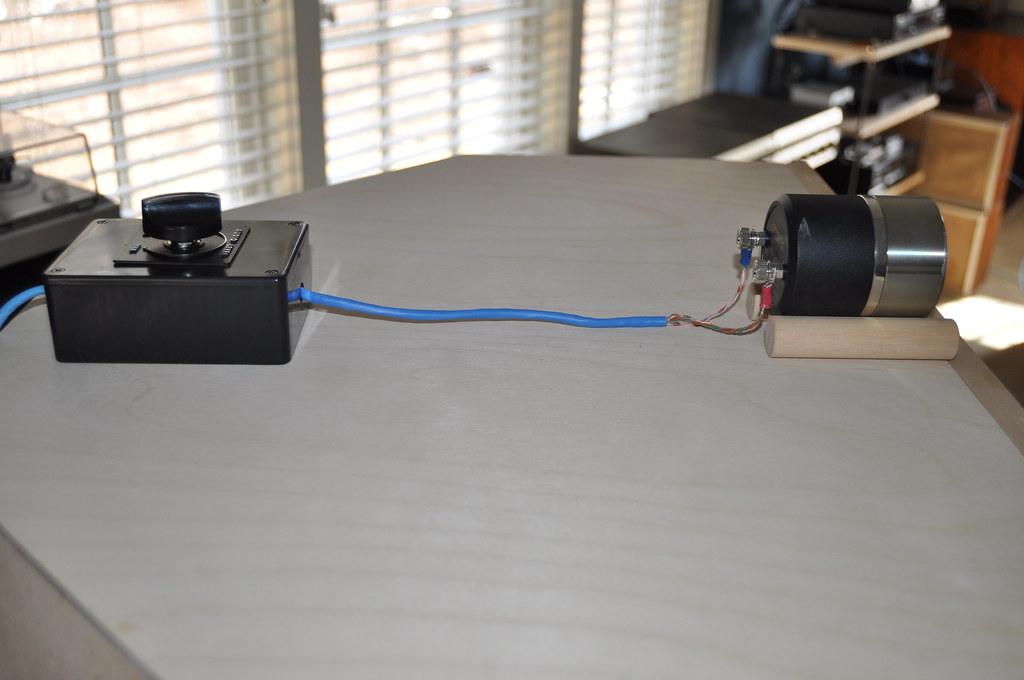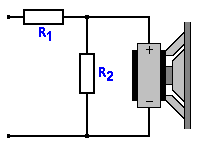Anyone ever add a tweeter control ?

Polkaguy58
Posts: 352
At the risk of once again seeming like a speaker defiler, has anyone here ever added an L-Pad tweeter control to their Polks ?
I always question whether what I sometimes percieve to be "not enough mid bass" to really be "too much high end"
Let the stoning begin (heh heh)
I always question whether what I sometimes percieve to be "not enough mid bass" to really be "too much high end"
Let the stoning begin (heh heh)
Post edited by [Deleted User] on
Best Answers
-
Nope, not me....wouldn't even consider the idea. If there is something amiss with the sound your getting, look into solving that issue with other parts of your system/sources.HT SYSTEM-
Sony 850c 4k
Pioneer elite vhx 21
Sony 4k BRP
SVS SB-2000
Polk Sig. 20's
Polk FX500 surrounds
Cables-
Acoustic zen Satori speaker cables
Acoustic zen Matrix 2 IC's
Wireworld eclipse 7 ic's
Audio metallurgy ga-o digital cable
Kitchen
Sonos zp90
Grant Fidelity tube dac
B&k 1420
lsi 9's -
If it was me I would first make sure its not your room that makes them sound that way. You might have some frequency cancelation/bounce happening. But if your room is good then try it. It is fun to experiment. Depending on your speakers I think most of them have a resistor in line to pad down the tweeter. Give it a shot and let us know what you find out. Everybody's hearing is different. You might hear higher frequencies then most people. My wife for example can hear past 22k and I can only hear 18k.Polk S10, S8, S4
Polk RT8
Polk Monitor 7s
Working on getting SDAs -
 075 by Mark Hardy, on Flickr
075 by Mark Hardy, on Flickr
I have NO insight, expertise nor perspective on the titular case of tweeter padding -- but, generically speaking, there's no shame in an L-pad, I'd opine :- )
The "best" thing to do, I'd posit:
Measure in-room frequency response of the speaker system with a decent RTA to see the magnitude of response anomaly (peak) one's dealing with.
Use a variable L-pad (downstream of the XO) to tune the tweeter output either by ear and/or via RTA.
Measure the series and parallel leg resistance of the "optimal" padding level and replace the variable L-pad with fixed resistors of decent quality.
OR
Based on the RTA data, construct a fixed L-pad of the desired attenuation using fixed resistors (e.g., 2 dB or 3 dB or whatever). Forumulae for pads (not just L-pads) are readily found, as are calculators. Here's one:
http://www.sengpielaudio.com/calculator-Lpad.htm
-
A little Blackhole5 or the like right behind the mids goes along way to cleaning things up.Political Correctness'.........defined
"A doctrine fostered by a delusional, illogical minority and rabidly promoted by an unscrupulous mainstream media, which holds forth the proposition that it is entirely possible to pick up a t-u-r-d by the clean end."
President of Club Polk
Answers
-
Get rid of the SL-1000'sDon't take experimental gene therapies from known eugenicists.
-
As a guy who's done his share of sound engineering, I've always liked having the option to blend the tweeter's output to the woofer's..............Oh and to xschop, I've already swapped the original tweets for the RDO's.
-
"Too much high end"? What speakers are these? My 1Bs didn't have enough treble.
-
I have no doubt that my room has something to do with it.
It's 10'x12', with old fashioned plaster walls and though I have mellowed it sonically with a couple of wall/floor rugs, I'm only sitting 5 to 6 feet from my mains.
I've just found that I like having the option of bringing my tweeter volume up from zero, to whatever blend pleases me.
Altec and JBL (along with countless other respected builders) find no harm in including a tweeter control, so it must have some merit.
I'm a guitar repairman and no stranger to wiring and may even possess the ability to dowel the 3/8" hole in the cab, should I not like the mod.
It will also give me the excuse to make better gaskets, tighten up the screw holes and seal up the insides better.
Had Mathew used cast metal speaker baskets, high end film capacitors, threaded metal screw inserts and overpriced acoustic foam, just think how much more his speakers would've cost ?
Maybe the same reasoning applied for the use of L-pads.
In any case, 30 dollars and a couple hours of work/fun won't be that bad.
-
Please take some pics so there is some documentation if someone else wants to try it.Polk S10, S8, S4
Polk RT8
Polk Monitor 7s
Working on getting SDAs -
I decided to give the room treatment another shot and added two corner bass traps in the alcove where my system (and sub) reside.
A buddy of mine, who owns a recording studio gave me some scrap acoustic foam, which I cut in half, then mitered the corners to 45 degrees.
Electric kitchen knives work wonders for foam sculpting.
I stage taped them in place (they're hidden behind the stereo rack), pointed my 5 Jr.s a little more toe inward and sat down to some Steely Dan.
The bass responce is noticably tighter and I think the speakers sound better angled inward more.
I'm not giving up on the tweeter L-pad, but should probably study up a little more on how the Jr's crossovers are designed.
-
Not sure if there is a frequency response out there for these speakers but I have notice a lot of speakers loose their higher frequencies when they are not pointing at you. At 15 and 30 degrees out the frequency drops quite a bit. So if you think they are too bright or not bright at all paly with the toe in and toe out to get them sound good to you.Polk S10, S8, S4
Polk RT8
Polk Monitor 7s
Working on getting SDAs -
I can see the allure if your a guitar guy, but most stay away from these types of devices because of added noise to the signal. Same reason many have dumped equalizers.
The speakers are pretty old though, and maybe some newer parts in the crossovers would help with bringing that top end back up to snuff. Just a thought....but hey, we all like what we like right ?HT SYSTEM-
Sony 850c 4k
Pioneer elite vhx 21
Sony 4k BRP
SVS SB-2000
Polk Sig. 20's
Polk FX500 surrounds
Cables-
Acoustic zen Satori speaker cables
Acoustic zen Matrix 2 IC's
Wireworld eclipse 7 ic's
Audio metallurgy ga-o digital cable
Kitchen
Sonos zp90
Grant Fidelity tube dac
B&k 1420
lsi 9's -
This^^^^^^^^
It's also acceptable to place the L-Pad before the Hi-Pass Circuit.Home Theater/2 Channel:
Front: SDA-2ATL forum.polkaudio.com/discussion/143984/my-2as-finally-finished-almost/p1
Center: Custom Built forum.polkaudio.com/discussion/150760/my-center-channel-project/p1
Surrounds & Rears: Custom Built forum.polkaudio.com/discussion/151647/my-surround-project/p1
Sonicaps, Mills, RDO-194s-198s, Dynamat, Hurricane Nuts, Blackhole5
Pioneer Elite VSX-72TXV, Carver PM-600, SVS PB2-Plus Subwoofer
dhsspeakerservice.com/ -
Many of those old Altecs and JBL's needed attenuation because of the poor (by today's standards) drivers and x-overs they were using. Tweeter design and materials have come a LONG way as well as much better x-over components being more affordable. Hi end gear is also more linear and revealing today than in those days. Also the digital age is here.
I've never heard or owned a Polk speaker that needed any sort of attenuation circuit, unless your listening environment is extremely deficient in some shape or form.
H9Post edited by heiney9 on"Appreciation of audio is a completely subjective human experience. Measurements can provide a measure of insight, but are no substitute for human judgment. Why are we looking to reduce a subjective experience to objective criteria anyway? The subtleties of music and audio reproduction are for those who appreciate it. Differentiation by numbers is for those who do not".--Nelson Pass Pass Labs XA25 | EE Avant Pre | EE Mini Max Supreme DAC | MIT Shotgun S1 | Puritan Audio PSM136 Pwr Condtioner & Classic PC's | Legend L600 | Roon Nucleus 1 w/LPS - Tubes add soul! -
I like what I'm hearing so far with just those new bass traps.
When stereo mastering, one often finds that it's the certain frequencies you pull back in the mix, that let the others shine through.
I believe now that the boominess of my sub in the plaster alcove was clouding the mid-bass on the Jr.s a bit.
I wish there was another spot to locate it, but my place is very small and the real estate all taken up.
My next step should be to connect with Westmassguy and get some crossovers rebuilt. (we're not too far from eachother).
As I understand it, new caps tighten things up.
I'll save the L-pad project until I think I really need it. -
You will be floored at how much better speakers will sound with a crossover refresh. Don't cheap out on the caps (do not use electrolytics) and use non-inductive wire wound resistors.
The rdo tweets and crossover refresh in every case of old Polks really made them sound great!"Appreciation of audio is a completely subjective human experience. Measurements can provide a measure of insight, but are no substitute for human judgment. Why are we looking to reduce a subjective experience to objective criteria anyway? The subtleties of music and audio reproduction are for those who appreciate it. Differentiation by numbers is for those who do not".--Nelson Pass Pass Labs XA25 | EE Avant Pre | EE Mini Max Supreme DAC | MIT Shotgun S1 | Puritan Audio PSM136 Pwr Condtioner & Classic PC's | Legend L600 | Roon Nucleus 1 w/LPS - Tubes add soul! -
Polkaguy58 wrote: »When stereo mastering, one often finds that it's the certain frequencies you pull back in the mix, that let the others shine through.
Isn't that what equalizers do ? Separate external crossovers with DSP ? Maybe pro gear is more suited for your needs.HT SYSTEM-
Sony 850c 4k
Pioneer elite vhx 21
Sony 4k BRP
SVS SB-2000
Polk Sig. 20's
Polk FX500 surrounds
Cables-
Acoustic zen Satori speaker cables
Acoustic zen Matrix 2 IC's
Wireworld eclipse 7 ic's
Audio metallurgy ga-o digital cable
Kitchen
Sonos zp90
Grant Fidelity tube dac
B&k 1420
lsi 9's -
What my post was infering to, is that the home made bass traps seem to have quelled the low frequency "boominess" that was masking the Jr.s sound, thus allowing the Polks to shine through.
They're not too bass heavy to begin with and need all the help they can get.
My next trick is to hang some insulated curtains in the rear of the little alcove in a heavily rippled fashion.
-
Update:
Well, I did in fact buy a set of what they call "Zero Sun" heavy drapes, along with a spring loaded rod to hang them with and hung them about 2 feet from the back wall of the alcove where my system resides.
(now there's a hidden spot to store my extra Polks)
The other thing I bought was 34"x60" faux wood blinds.
If you own one of those metal baker's racks, you can zip tie the blinds to the top rear shelf, then pull them down to the bottom of the rack, thus creating a backdrop, that lets you snake your wires in and out of the slats, for a cool mess free system.
I also picked up a couple small fuzzy bordered rugs and stapled them to the hollow core doors in my listening room.
The room is quite still now and you can actually hear the difference if you walk into it while talking to someone (or yourself for that matter) from the hallway.
The final result is very nice tight bass response and I can hear every little detail in the upper frequencies.
A great project for a below freezing afternoon.




